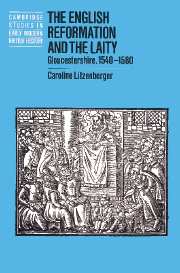Book contents
- Frontmatter
- Contents
- List of figures
- List of tables
- Acknowledgments
- Abbreviations and conventions
- Introduction
- 1 Setting the scene
- 2 Gloucestershire in the 1530s
- 3 The new diocese of Gloucester (1540–1546)
- 4 The advent of Edwardian Protestantism (1547–1553)
- 5 A return to the old religion (1553–1558)
- 6 The early years of Elizabeth's reign (1559–1569)
- 7 The clarification of the religious settlement (1570–1580)
- Conclusion
- Appendix A Sources and methodology
- Appendix B Results of wills analysis
- Appendix C Parish finances
- Bibliography
- Index
- Cambridge Studies in Early Modern British History
6 - The early years of Elizabeth's reign (1559–1569)
Published online by Cambridge University Press: 23 November 2009
- Frontmatter
- Contents
- List of figures
- List of tables
- Acknowledgments
- Abbreviations and conventions
- Introduction
- 1 Setting the scene
- 2 Gloucestershire in the 1530s
- 3 The new diocese of Gloucester (1540–1546)
- 4 The advent of Edwardian Protestantism (1547–1553)
- 5 A return to the old religion (1553–1558)
- 6 The early years of Elizabeth's reign (1559–1569)
- 7 The clarification of the religious settlement (1570–1580)
- Conclusion
- Appendix A Sources and methodology
- Appendix B Results of wills analysis
- Appendix C Parish finances
- Bibliography
- Index
- Cambridge Studies in Early Modern British History
Summary
Following Mary's death in November 1558, Elizabeth acceded to the throne. Religious uncertainty would be the watchword in the diocese of Gloucester and the rest of the realm during the first decade of her reign. The queen's apparent ambivalence regarding official religious policy during those years exacerbated an otherwise difficult situation locally. The Marian Bishop of Gloucester, James Brookes, had died just before the end of Mary's reign and would not be replaced for over three years. Thus the diocese of Gloucester was set religiously adrift. Brookes, and before him, John Hooper, had set clear if contrasting standards of religious belief and behaviour during the preceding decade, but now the see of Gloucester was vacant. The eventual selection of Richard Cheyney as bishop would only compound the problem. With a theology that even his contemporaries had difficulty categorising, plus an administrative style which has been characterised variously as ‘dreamy’ and ‘pathetically weak [and] irresolute’, his elevation to the episcopacy did little to arrest the drift begun earlier.
Initially, Elizabethan Protestantism was a restoration of most of the beliefs and practices of the last years of Edward's reign; but exactly what did that include? The liturgy of 1552 was modified by replacing the rubric concerning vestments in that book with the more traditional proviso on that subject contained in the Prayer Book of 1549. In addition, confusion arose as a result of conflicting directives in the Prayer Book of 1559 and the Royal Injunctions of the same year concerning the approved form of communion bread and the official policy on images. Compounding the apparent confusion in direction provided by official policy, the hotter sort of Protestants, especially those just returning from exile on the continent, were looking forward to a continuation of the changes which had begun in England in the early 1550s, and which they had found in the churches of Zurich and Geneva.
- Type
- Chapter
- Information
- The English Reformation and the LaityGloucestershire, 1540–1580, pp. 104 - 125Publisher: Cambridge University PressPrint publication year: 1997



